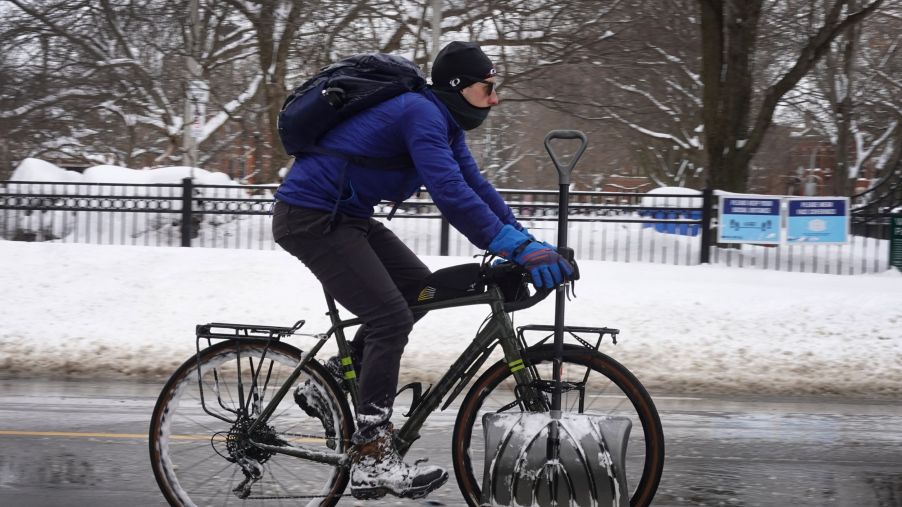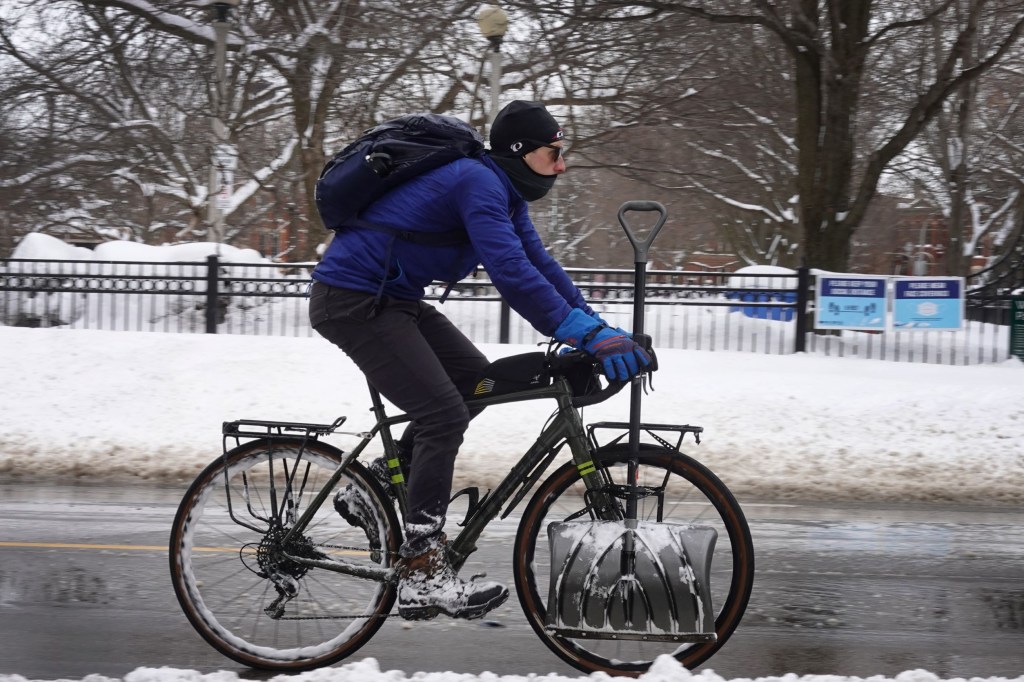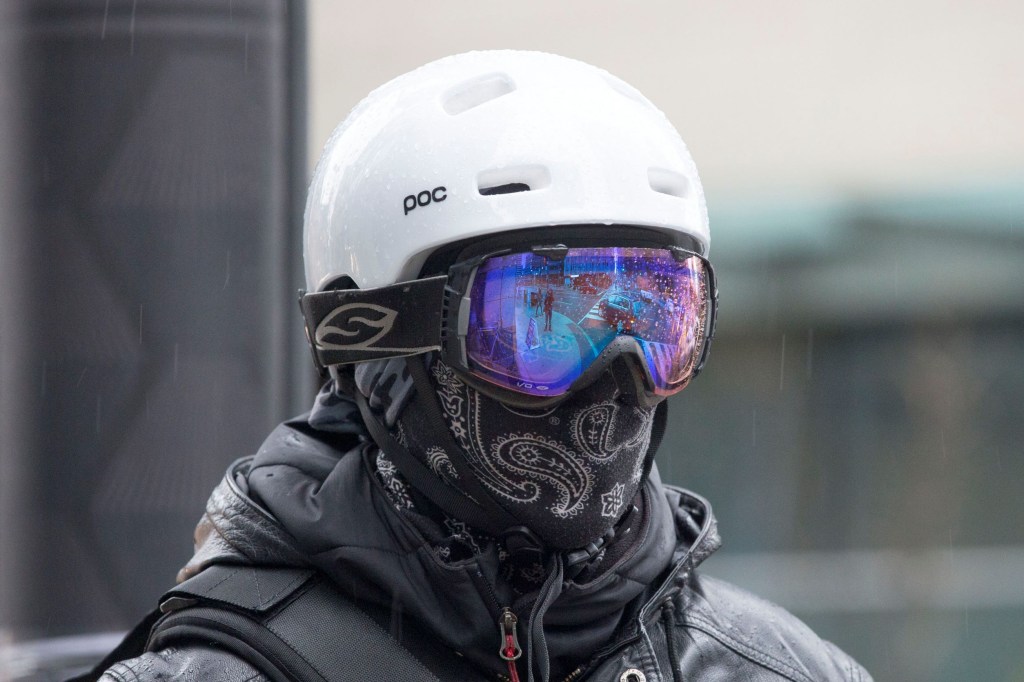
With the Right Cycling Gear, Cold Winter Weather Is Nothing to Fear
A dropping mercury is usually the signal to break out the snow tires and put corrosion-prone classics to sleep until spring. And for many, it’s also the end of riding season, both for motorcycles and bicycles. However, just because it’s cold outside doesn’t mean the ride has to stop for either kind of bike. By carefully considering their gear, motorcyclists can keep warm even in winter. And you, too, can pedal through the chilly weather with the right winter cycling gear.
All good winter cycling gear strategies start with knowing your layers

Although bicycles, even e-bikes, can’t reach motorcycle speeds, cyclists and motorcyclists have at least one common enemy: wind chill. Even if the wind isn’t blowing, you moving through it accelerates heat transfer between your body and the air. Put simply, the faster you go, the faster you lose body heat.
Cyclists don’t move fast enough to make windshields effective, even if bicycles accommodated them. But like anyone who’s spent time in cold climates, rider or not knows, moving out of the wind’s way isn’t your main heat-retention strategy. Instead, you trap body heat and air between layers of clothing, keeping heat from escaping and adding extra insulation. That’s why winter cycling gear, such as gloves, tights, and shoes, is specially-insulated, Bicycling notes.
However, there is such a thing as too many layers—or rather, an improper layering strategy. If you’re too warm, you start to sweat. And a sweat-soaked cotton shirt doesn’t retain heat; in the winter, it’s a recipe for hypothermia, Cyclist explains. So, what you need to start your winter cycling gear closet is a sweat-wicking, close-fitting base layer made out of merino wool or synthetic fabrics. A heat-retaining mid-layer goes on top of that, followed by a wind-proof outer layer that’s at least water-resistant. And ideally, that outer layer also has ways to vent moisture and sweat as needed.
Winter cycling gear includes more than just clothing
A proper layering strategy might be the cornerstone of your winter cycling gear arsenal, but it’s not actually gear. So, what do you need when the cold and snow hit?
Ultimately, your specific winter cycling gear setup depends on the kind of weather you ride in. Mild winters with little rain or snow don’t necessarily require heavy insulation and waterproof clothing. On the other hand, as a Midwestern cyclist, I’ve regularly dealt with temperature swings, snow, ice, and slush—sometimes all in one ride. As such, Bicycling recommends bringing backup gear so you can handle changing conditions appropriately.
But while every cyclist is different, most winter cycling gear closets will contain the following:
- A balaclava or an insulated cap combined with a neck gaiter
- Waterproof gloves, preferably ‘lobster gloves’ with joined fingers
- Long insulated tights and, as needed, trail pants
- Appropriate base and mid-layers
- Water-resistant or waterproof jacket
- Insulated winter cycling shoes or insulated shoe covers/overshoes
- Wool and/or synthetic socks
- Eye protection (glasses or goggles)

Although cycling gear is optimized for cycling-specific needs, don’t feel limited to it, Bicycling advises. If you have appropriate cold-weather athletic gear, you can wear that on winter rides, too. Ski goggles easily double as cycling goggles, for example.
However, winter cycling gear is more than just clothes. Traction is just as important for bicycles as it is for cars and motorcycles, especially in winter. That’s why, again, like cars and motorcycles, bikes have winter tires, too, even studded ones. They won’t stop all slides, and they do increase pedaling effort, but they do improve your grip. Plus, it’s not just you that needs insulation, but your water, too, or else it’ll freeze. So, get an insulated bottle.
Also, even in stark-white snow, visibility is vital for cyclists. Not just because you need to see, but because other people need to see you. That means not only high-vis clothing but headlights and taillights as well. Some e-bikes have built-in lighting, but if your bike doesn’t, you’ll need some accessory lights.
When cold weather and salty slush hit, your bicycle needs care, too
Speaking of e-bikes, your bicycle is just as much a part of your winter cycling gear as your clothes. And winter is just as hard on your bike as it is on you. Road debris and dirt can damage delicate components, and dirty slush filled with road salt is a recipe for rust.
The ideal preventative measure is to wash your bicycle after every ride, Bicycling says, but that’s not always feasible. However, you should at least wipe the bike down after a ride, especially parts like the chain, derailleurs, and brakes. But make sure you use a ‘wet’ chain lube formulated for winter conditions, REI reports. WD-40 is not a chain lube, but it can protect your frame from grime, Bicycling notes. And for extra frame protection, consider installing mudguards or fenders.
If you’re riding an e-bike, though, there’s something else you need to monitor: your battery. Bicycles can’t get hypothermia, but batteries drain faster in the cold. So, if possible, remove the battery and charge it indoors. And consider bringing along a second battery just in case.
Riding through the snow, or at least the cold isn’t as simple as cycling in the summer. But by thinking ahead, and with the right cycling gear, winter can be just another riding season.
Follow more updates from MotorBiscuit on our Facebook page.


